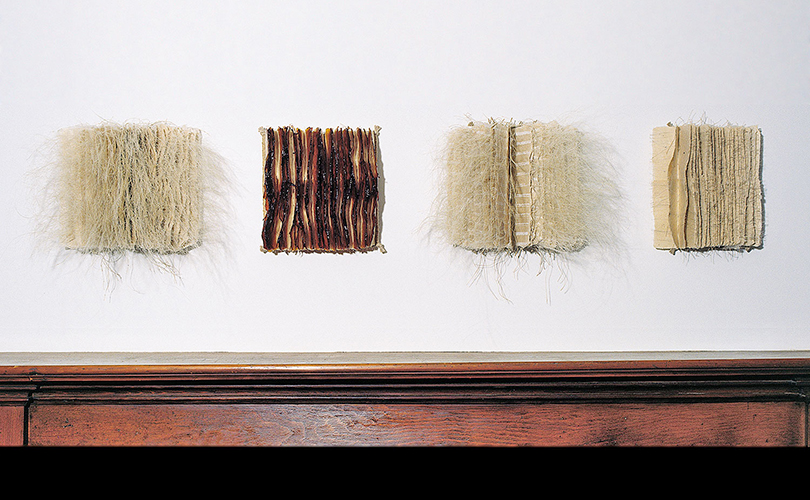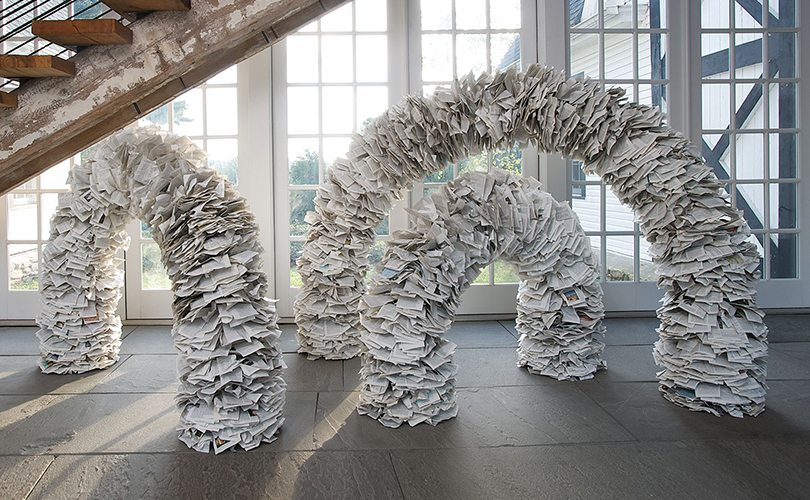
“With all sorts of ideas behind them, artists continue to challenge the idea, content, and structure of the traditional book,” observed Anne Evenhaugen, in Unbound, the Smithsonian Libraries and Archives, online newsletter in 2012 (https://blog.library.si.edu/blog/2012/06/01/what-is-an-artists-book/). Several artists who work with browngrotta arts do all that to books and more. Below are some examples of how the printed page forms or features in their work.


For some it’s a literal homage. John McQueen makes actual books of twigs and waxed linen. Their pages turn and the words on the pages can be read. Caroline Bartlett’s version is more of an idea, a memory, than an actual book. In her Overwritings series, cotton thread, plastered fabric, matchsticks, and waxed resisted silk fragments create marks that reference text that viewers are left to decode. The volumes in Lewis Knauss’ Book series also read as books, but are even more abstract. Knauss uses linen, hemp, Japanese paper, and shellac to create ruffled pages without text. Mercedes Vicente uses notebook paper to create a book and a thin black cord to “write” on the pages.


Other artists use the printed page as material. For Toshio Sekiji, it’s newspapers, book jackets, and maps that make up his collage/weavings. He explores the merge of cultures in his works. New stories are created atop the old he says, by reading the strips of paper he chooses and the areas he enhances with lacquer. Encyclopedia pages are used as Wendy Wahl‘s as material. “… [t]he leaves may be stacked into forms that suggest an alternative forest of knowledge or tightly scrolled and packed within a frame, making for a composition that suggests a cabinet of hidden knowledge, those archives of information that are at once visible and concealed, at hand and remote.” Akiko Busch, wrote in our catalog, 10th Wave III. Naomi Kobayashi creates her own text, then incorporates it into delicate weavings. In a true “art imitates life imitates art” moment, a collector of her work who is a writer asked a technical question. If the work were unraveled, could the text be read? Yes, the artist answered and it became a plot twist — in his book, Hiding in the Weave, a student’s tapestry has to be unwoven to discover a clue to her death.

Lawrence LaBianca looks at books from different vantage points. In Thesaurus, he posits a slice of a tree with its mirror image in glass as book pages that can be read. What Lies Beneath, is a bit tongue in cheek. In this work, he considers an iconic book, Moby Dick, from the perspective of fish. He sent it into the ocean in a waterproof box and filmed it in place.

Francis Bacon got it right in our view, when he said, “Some books are to be tasted, others to be swallowed, and some are to be chewed and digested.” (Essays (1625)) Bacon’s Essays By Francis Bacon, Richard Whately.) Those are just some of the options available to artists considering books as inspiration. As viewers, we are left to anticipate and appreciate the works that result.
